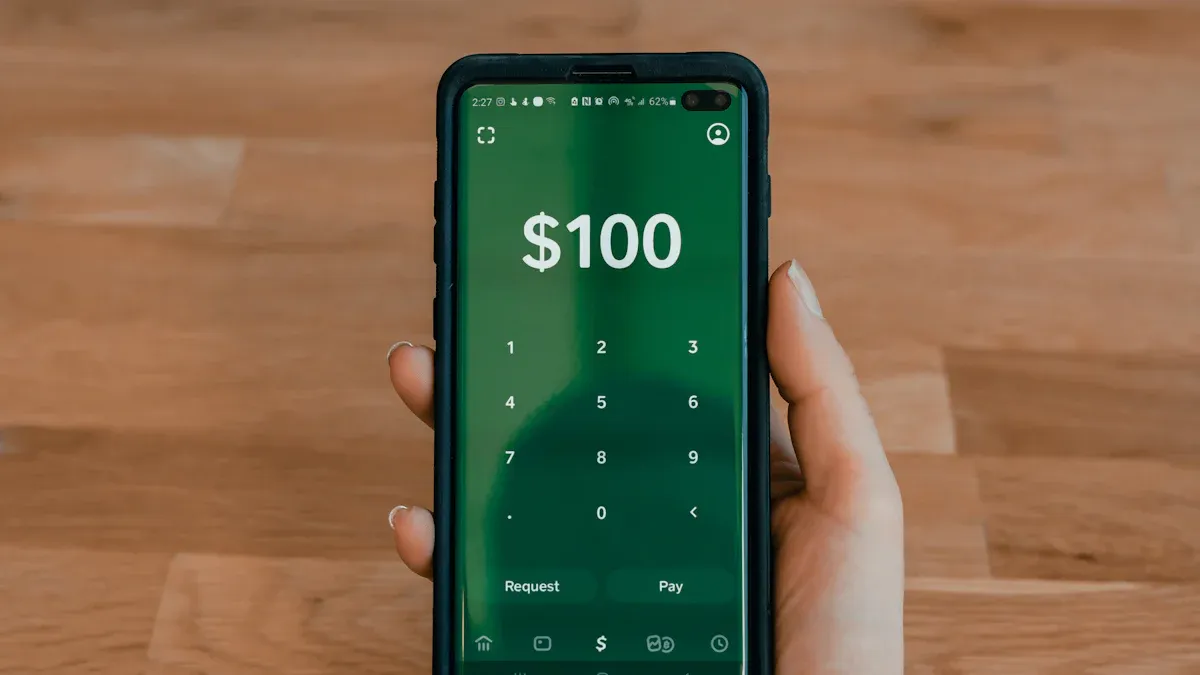- EasyCard
- Trade
- Help
- Announcement
- Academy
- SWIFT Code
- Iban Number
- Referral
- Customer Service
- Blog
- Creator
Analysis of Cash App's Sending Limits: How to Increase Transfer Limits and Optimize Fund Management?

Image Source: unsplash
Have you ever been frustrated by Cash App’s transfer restrictions? An unverified account can only send up to $250 per week. Fortunately, the solution is straightforward: complete identity verification.
Key Tip: By verifying your identity, your weekly sending limit can significantly increase, and there will be no limit on receiving funds.
With Cash App’s user base projected to exceed 54 million in 2025, fully understanding account features becomes crucial. This Cash App sending limit guide will help you master the key to managing large funds.
Key Points
- Unverified Cash App accounts have low transfer limits, allowing a maximum of $250 sent per week and $1,000 received per month.
- Completing identity verification can significantly increase transfer limits, with a weekly sending limit of up to $7,500 and no limit on receiving funds.
- The identity verification process is simple, requiring only your name, date of birth, and the last four digits of your SSN, though sometimes an ID and selfie may be needed.
- Verifying your identity not only increases limits but also enhances account security and unlocks advanced features like stock investing and Bitcoin trading.
- Sending limits and withdrawal limits are different; identity verification primarily increases sending limits, while ATM withdrawal limits remain $1,000 daily and weekly.
Cash App Sending Limit Explained
To fully utilize Cash App, you first need to understand its limit system. Your account’s verification status directly determines your transfer capabilities. This detailed Cash App sending limit guide will clarify all key figures, helping you decide when to upgrade your identity status.
Limits for Unverified Accounts
When you first sign up for Cash App, your account is unverified. This status offers basic account functionality, designed primarily for small, occasional transactions. You need to be aware of the following two core restrictions:
- Sending Limit: Within any 7-day period, you can send a maximum of $250.
- Receiving Limit: Within any 30-day period, you can receive a maximum of $1,000.
Important Note: These limits are calculated on a “rolling period,” not resetting by calendar week or month. For example, if you send $250 on Monday, you must wait until the following Monday to send funds again, not the end of the next Sunday. This mechanism directly impacts fund planning.
For users who only use Cash App for occasional splitting of restaurant bills with friends, this limit may suffice. However, if you plan to use it for paying bills or more frequent transfers, you’ll quickly hit the ceiling.
Higher Limits for Verified Accounts
Completing identity verification is the only way to unlock Cash App’s full potential. Once your account is verified, the freedom of fund movement will see a qualitative leap.
The most significant change is that your weekly sending limit will increase to $7,500. This limit applies to most daily transactions, including:
- Peer-to-peer (P2P) transfers to friends and family
- Withdrawals to your linked bank account
- Payments to merchants that accept Cash App
Even better, verified accounts have unlimited receiving limits. This means you can confidently receive any amount without worrying about exceeding restrictions.
What’s the $17,500 Limit You May Have Heard About?
You may have seen mentions online of a $17,500 weekly sending limit. To clarify, this higher limit does not apply to standard personal transfers. It is typically associated with specific features, such as:
To help you better understand the differences, here’s a comparison table. This is the core of this Cash App sending limit guide:
| Feature | Unverified Account | Verified Account |
|---|---|---|
| Sending Limit | $250 per 7 days | $7,500 per 7 days |
| Receiving Limit | $1,000 per 30 days | Unlimited |
| Calculation Period | Rolling Period | Rolling Period |
In summary, spending a few minutes to complete identity verification can transform a restricted pocket-change tool into a powerful personal fund management platform.
Step-by-Step Guide to Increasing Sending Limits

Image Source: unsplash
Now that you understand the significant differences between verified and unverified accounts, the next step is to complete identity verification. This process is not only simple but also unlocks Cash App’s full potential. This guide will walk you through the steps.
Why Verify Your Identity?
You might wonder why transferring funds requires providing personal information. Increasing limits is just one reason. Identity verification offers three main benefits:
- Compliance with Federal Regulations: As a financial service provider, Cash App must comply with U.S. financial regulations. This includes strict “Know Your Customer” (KYC) requirements under the Bank Secrecy Act (BSA). The Financial Crimes Enforcement Network (FinCEN) requires financial institutions to collect user information to prevent money laundering and other illegal financial activities. Identity verification is the foundation for ensuring the platform operates legally and compliantly.
- Enhanced Account Security: Verifying your identity is a critical step in protecting your funds. Cash App uses advanced fraud detection algorithms to flag suspicious activity. Once verified, your account gains an additional layer of protection. In case of a lost phone or unusual login activity, verified identity information can help you recover account access more quickly and effectively prevent unauthorized transactions.
- Unlock Advanced Features: Verifying your identity isn’t just about increasing limits as outlined in this Cash App sending limit guide. It’s also the gateway to more advanced features. If you want to use Cash App for stock investing or Bitcoin trading, identity verification is a prerequisite.
One-Sentence Summary: Identity verification = higher limits + stronger security + more features. It’s an action that benefits you in every way.
Personal Information Required for Verification
To complete verification, you need to prepare some basic personal information. Ensure the information you provide is completely accurate and matches your official documents to avoid verification failure.
Typically, Cash App will require the following information:
- Your full legal name
- Your date of birth
- The last four digits of your Social Security Number (SSN)
Important Note: In some cases, such as when the system cannot verify your identity with basic information or if you’re applying for features requiring stricter scrutiny, Cash App may request additional information, including:
- Your full Social Security Number (SSN)
- A valid government-issued photo ID (e.g., driver’s license or passport)
- A selfie for comparison with the photo on your ID
With this information prepared, the entire verification process can be submitted within the app in just a few minutes.
Steps Within the App
Initiating identity verification within Cash App is very intuitive. Follow these steps:
- Open Cash App and tap the profile icon in the top-right corner of the home screen.
- Scroll down the menu and tap the “Security & Privacy” option.
- In the “Security & Privacy” page, find and tap the “Identity Verification” section.
- Follow the on-screen prompts to enter your full legal name, date of birth, and the last four digits of your SSN.
- If prompted, use your phone’s camera to take a photo of your ID and complete a selfie as instructed.
- Review all information for accuracy and tap Submit.
After submission, your account status will show “Verification in Progress.”
How Long Does Verification Take?
The verification process typically takes about 48 hours. In most cases, if the information is clear and correct, verification is completed quickly. During holidays or periods of high request volume, there may be slight delays.
If verification fails, don’t worry. The most common reasons are incorrect information or poor photo quality. Refer to the table below for solutions:
| Common Failure Reasons | Solutions |
|---|---|
| Information Mismatch | Double-check that your name, date of birth, and SSN match your official documents exactly. |
| Poor Photo Quality | Retake photos in a well-lit area, ensuring they are clear, without glare or blur. |
| Expired ID | Ensure you use a government-issued ID that is still valid. |
| App Technical Issues | Try updating Cash App to the latest version or restarting your phone before retrying. |
Once verified, you can say goodbye to low limits and transform Cash App into a powerful, flexible fund management tool.
Fund Management Strategies and Common Questions

Image Source: pexels
After completing identity verification, you’ll unlock higher limits. Now, let’s explore some advanced fund management strategies and common questions to help you use Cash App more efficiently.
Transferring to Yourself and Limit Usage
You might wonder if transferring funds to another account you own counts toward your limit. The answer is yes.
When you use Cash App to transfer funds to yourself, this counts as a transaction and is included in your weekly sending limit. If you’ve reached your limit, you’ll need to wait until the limit resets before transferring again. Therefore, you need to plan your fund movements in advance.
Tracking your limits wisely ensures you can always transfer funds when needed.
Setting Up Recurring Transfers for Automated Savings
Automation is the cornerstone of efficient financial management. Cash App’s recurring transfer feature can help you automate savings or bill payments, saving you time and effort. You can use this feature to consistently contribute to your financial goals.
Setting up recurring transfers is very simple:
- Tap the payment tab (dollar sign “$”) on the home screen.
- Enter the recipient’s information, amount, and transfer note.
- On the confirmation page, look for the “Schedule” option.
- Choose your desired transfer frequency, such as daily, weekly, or monthly, and set a start date.
- Review all information and confirm the payment.
Note: Recurring transfers are also subject to your account’s sending limit. Ensure your plan stays within your account’s limits.
How to Check Limits in the App
Want to know how much limit you have left? Cash App provides a very convenient way to check. You can view your limit status at any time to better plan large transactions.
Follow these steps:
- Tap the profile icon in the top-right corner of the home screen.
- Go to “Account & Settings.”
- Tap “Limits” to view your current sending, withdrawal, and other limits.
Difference Between Withdrawal Limits and Sending Limits
This is a crucial distinction, as many people confuse the two. Simply put, sending limits and withdrawal limits are calculated separately.
- Sending Limit: Refers to the amount you can transfer or pay through the app, with verified accounts having a weekly limit of $7,500.
- Withdrawal Limit: Refers to the amount you can withdraw using your Cash Card at an ATM. This limit is fixed, set at $1,000 daily and weekly.
Key Difference: Completing identity verification significantly increases your sending limit but does not affect ATM withdrawal limits. These two limits are calculated separately and do not affect each other.
Understanding these strategies and distinctions will help you manage your Cash App funds with greater confidence.
Now, you’ve fully grasped the core of Cash App limits. Knowing the default limits is the foundation, and completing identity verification is the only way to increase them. This process is typically quick:
- Submitting information takes just a few minutes.
- The review process may take up to 48 hours.
Be sure to check your limits in the app regularly. Take action to transform Cash App from a simple payment tool into a powerful personal fund management platform.
FAQ
What happens if I send funds to an unverified account?
You can still send funds to an unverified account. However, the recipient will be subject to a $1,000 monthly receiving limit. If your transfer causes them to exceed this limit, the transaction may fail.
Can I try again if verification fails?
Absolutely. If your identity verification fails, you can resubmit your application at any time. Before retrying, carefully check that your information is accurate and ensure your ID photos are clear and free of glare.
Are the limits for a Business Account the same as a personal account?
No. Cash App Business Accounts typically have higher receiving limits and may have different fee structures. If you plan to frequently receive business payments, consider researching and switching to a Business Account.
Does increasing the sending limit cost money?
No. Completing identity verification to increase your sending limit is completely free. It’s a standard process set by Cash App to comply with financial regulations and protect account security.
*This article is provided for general information purposes and does not constitute legal, tax or other professional advice from BiyaPay or its subsidiaries and its affiliates, and it is not intended as a substitute for obtaining advice from a financial advisor or any other professional.
We make no representations, warranties or warranties, express or implied, as to the accuracy, completeness or timeliness of the contents of this publication.




Contact Us
Company and Team
BiyaPay Products
Customer Services
is a broker-dealer registered with the U.S. Securities and Exchange Commission (SEC) (No.: 802-127417), member of the Financial Industry Regulatory Authority (FINRA) (CRD: 325027), member of the Securities Investor Protection Corporation (SIPC), and regulated by FINRA and SEC.
registered with the US Financial Crimes Enforcement Network (FinCEN), as a Money Services Business (MSB), registration number: 31000218637349, and regulated by FinCEN.
registered as Financial Service Provider (FSP number: FSP1007221) in New Zealand, and is a member of the Financial Dispute Resolution Scheme, a New Zealand independent dispute resolution service provider.



















